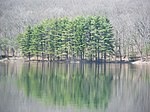Mount Tom B-17 crash
1946 in MassachusettsAccidents and incidents involving United States Air Force aircraftAviation accidents and incidents in MassachusettsAviation accidents and incidents in the United States in 1946Aviation accidents and incidents involving the Boeing B-17 Flying Fortress ... and 2 more
History of Holyoke, MassachusettsJuly 1946 events in the United States

On July 9, 1946, a Boeing B-17 Flying Fortress crashed into Mount Tom outside Holyoke, Massachusetts, United States. The crash and resulting explosion killed all 25 passengers and crew. It was the deadliest aviation accident in New England until the crash of Eastern Air Lines Flight 375 in 1960.
Excerpt from the Wikipedia article Mount Tom B-17 crash (License: CC BY-SA 3.0, Authors, Images).Mount Tom B-17 crash
Whiting Reservoir Road, Holyoke
Geographical coordinates (GPS) Address Nearby Places Show on map
Geographical coordinates (GPS)
| Latitude | Longitude |
|---|---|
| N 42.245833333333 ° | E -72.642777777778 ° |
Address
Silvio O. Conte National Wildlife Refuge
Whiting Reservoir Road
01040 Holyoke
Massachusetts, United States
Open on Google Maps







